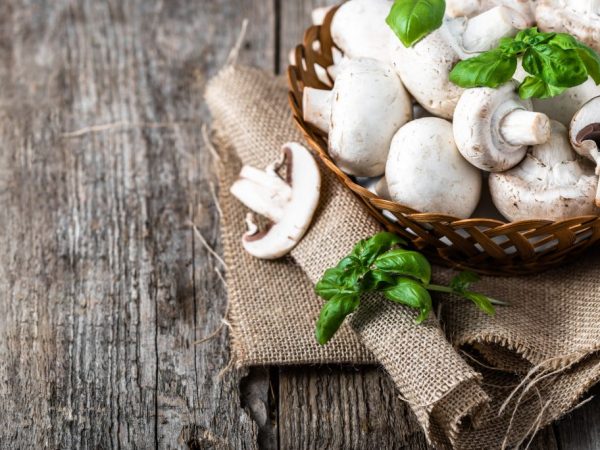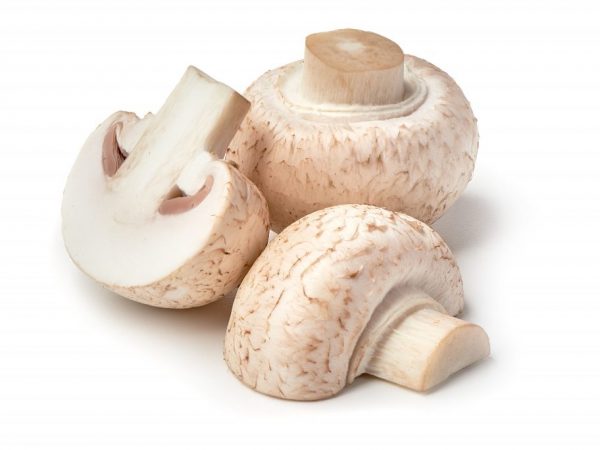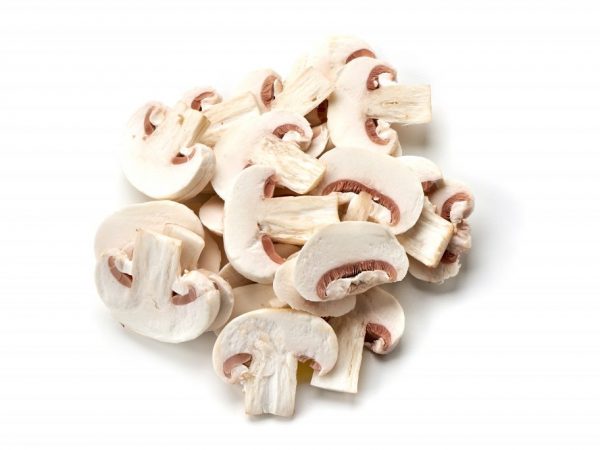Calorie champignons
The low calorie content of champignons allows people who watch their weight to include these mushrooms in their meals with virtually no restrictions.

Calorie champignons
Nutritional value of the product
In the table of calorie content of champignons, the composition of BJU mushrooms (in grams) is presented:
| Protein | up to 4.3 |
| Fats | up to 1 |
| Carbohydrates | up to 0.1 |
| Alimentary fiber | up to 2.6 |
| Water | up to 91 |
| Ash | up to 1 |
Mushrooms contain proteins and a small amount of fat, which makes them an indispensable product in the diet.
At the same time, the amount of calories contained in mushrooms depends on the method of their preparation:
- the calorie content of fresh champignons is 27 kcal per 100 g of mushrooms;
- the calorie content of mushrooms, grilled with oil, starts from 35 kcal;
- steamed and boiled mushrooms contain an amount of calories similar to fresh ones, however, it should be borne in mind that it increases with the use of salt and seasonings;
- the calorie content of canned champignons is lower than the calorie content of these fresh mushrooms, they contain about 18-20 kcal;
- the calorie content of 100 g of fried champignons counts from 44 calories and above;
- in stewed mushrooms, the number of calories is about 50.
Chemical composition
The chemical composition of champignons is represented by a vitamin-mineral complex and organic acids present.
Vitamins per 100 g of product:
- ascorbic acid (vitamin C) - 7 mg;
- PP - 5.6 mg;
- niacin - 4.8 mg;
- A - 2 μg;
- pantothenic acid - 2.1 mg;
- riboflavin - 0.45 mg;
- thiamine and alpha-tocopherol - 0.1 mg each;
- beta-carotene - 0.01 mg;
- pyridoxine (a form of vitamin B6) - 0.05 mg;
- folates (folic acid) 30 mcg

Champignons are rich in nutrients
The amount of macronutrients per 100 g of product:
- potassium - 530 mg;
- phosphorus - 115 mg;
- chlorine - 25 mg;
- magnesium - 15 mg;
- sodium - 6 mg;
- calcium - 4 mg.
The amount of trace elements per 100 g of product:
- rubidium - 26 mcg;
- iodine - 18 mcg;
- cobalt - 15 mcg;
- fluorine - 14 μg;
- chromium - 13 mcg;
- molybdenum - 3 mcg;
- iron - 0.3 mg;
- zinc - 0.28 mcg.
Irina Selyutina (Biologist):
As has long been known, in the composition of living organisms at the moment, thanks to modern methods of chemical analysis, the presence of more than 80 elements of the chemical table of D.I. Mendeleev has been reliably proven. According to their quantitative ratio in the cell, these substances are divided into the following groups:
- Macronutrients: they make up the bulk of the dry matter and take part in the construction of organic compounds of all living organisms. Their number ranges from 10 to 0.001% of body weight.
- Trace elements: these are mainly heavy metal ions, constituents of enzymes. Their concentration is 0.001-0.000001%.
- Ultramicroelements: their concentration does not exceed 0.000001. So far, their physiological significance for living organisms has not been precisely established.
The ratio of organic acids per 100 g of product:
- fatty omega-6 - 0.49 g;
Irina Selyutina (Biologist):
Almost everyone has heard of omega-6 and omega-3 fatty acids.From the point of view of chemical science, omega-6 present in the fruiting body of mushrooms belongs to the group of unsaturated fatty acids that have a double, the so-called. carbon-carbon (C = C) bond between 6 and 7 carbon atoms (C) in the so-called "Omega-6 positions", if you start reading the formula of the compound to count the carbon atoms from the methyl (-CH3) the end of the fatty acid.
By the way. Saturated fatty acids are characterized by the absence of such carbon-carbon double bonds.
- saturated fatty acids - only 0.131 g, among them: capric - 0.001 g, myristic - 0.033 g, palmitic - 0.059 g, stearic - 0.008 g;
- monounsaturated fatty acids - only 0.146 g, among them palmitoleic - 0.072 g, oleic - 0.037 g;
- polyunsaturated fatty linoleic acid - 0.491 g.
Among the carbohydrates assimilated by the body, mushrooms contain mono- and disaccharides. Their number is less than 1 mg per 100 g of product.
Beneficial features
The health benefits of champignon mushrooms are provided by their chemical composition.
B vitamins
Vitamin B group takes an active part in human life:
- vitamin B2: is a participant in redox processes (ORP or ORP), acts as a regulator of the perception of colors by the visual organs, provides dark adaptation (adaptation to vision in the dark), its deficiency affects the quality of the skin and mucous membranes, disrupts the quality of visual perception of light and twilight,
- vitamin B5: takes part in the metabolic processes of proteins, carbohydrates, fats and cholesterol, with its help the synthesis of hormones and hemoglobin occurs, affects the quality of absorption of amino acids and saccharides by the intestinal tract, provides support to the adrenal glands, its lack causes a change in the integrity of the skin epithelium and mucous membranes.
Vitamin PP

Mushrooms contain vitamins necessary for humans
The vitamin component PP takes part in the energy-metabolic process, its shortage causes a change in the qualitative characteristics of the skin epithelium, destabilization of the activity of the gastrointestinal tract and cells of the nervous system.
Potassium
Potassium acts as the main intracellular ion involved in regulating the balance of acid, water and electrolytes, serves as a conductor of nerve impulses and regulates blood pressure. For your information. Potassium is an essential component of the so-called. "Sodium-potassium pump", or "sodium-potassium pump" - an enzyme belonging to the group of transport adenosine triphosphatases responsible for the transfer of K ions across the cell membrane+ and Na+.
Phosphorus
Phosphorus is a participant in most physiological processes, including energy metabolism and acid-base balance. It is present in the composition of nucleic acids and phospholipids necessary for the processes of mineral supply of bone tissue and tooth enamel.
Iodine
Iodine is an indispensable element for the normal functioning of the thyroid gland. It organizes the process of hormonal morphogenesis: thyroxine and triiodothyronine, which are necessary in the process of cell growth and development, which is important for mitochondrial (intracellular) respiration and regulation of sodium and hormone transport. Its deficiency leads to a slowdown in the metabolic process, delay in development and growth.
Cobalt
The cobalt content ensures the activation of the metabolism of fatty acids and folic acid. Cobalt is present in the vitamin B12 molecule, where its mass fraction is 4%. With a lack of this vitamin in the body, a person develops malignant (pernicious) anemia.
In addition, cobalt is characterized by an effect on:
- metabolism of carbohydrates and lipids;
- thyroid function;
- the state of the myocardium.
Chromium
The presence of chromium makes it possible to regulate glucose levels in the blood, causing an increase in insulin action. Its deficiency lowers the body's susceptibility to glucose.
Conclusion
The chemical composition of champignons includes proteins, fats, carbohydrates and a set of vitamin and mineral components that are beneficial to human health. The main indicator of the calorie content of raw mushrooms is 27 kcal per 100 g and varies depending on the method of preparation.



